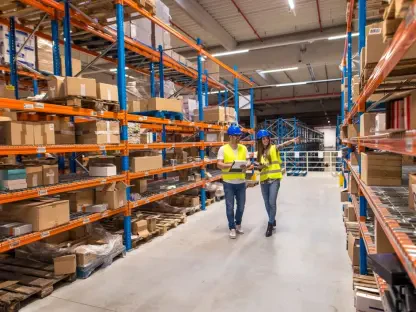The year 2025 looms on the horizon, bringing with it significant changes and challenges to the realm of Mexico’s cross-border freight and trade. As demands rise, tariffs shift, and U.S.-Mexico trade relations evolve, shippers must adapt their logistics strategies to navigate these disruptions effectively. Sunset Transportation, a leading logistics provider, emphasizes the critical importance of staying agile and informed in response to this evolving landscape.
The Importance of Adapting to New Regulations
Projected Growth in Exports and Nearshoring
One of the most pressing challenges anticipated by 2025 is the projected growth in exports from Mexico to the U.S., which are expected to increase by a staggering 34% over the next five years. This growth is largely driven by nearshoring efforts, where businesses aim to minimize supply chain risks by relocating production closer to their final markets. As Lindsey Graves, CEO of Sunset Transportation, highlights, partnering with logistics experts who possess deep knowledge of both local and global regulations is essential for optimizing cross-border operations.
The interplay between new regulations and export growth necessitates a profound understanding of the regulatory landscape. With nearshoring comes the need to comply with an array of new rules designed to facilitate closer economic ties between Mexico and the U.S. These regulations could encompass everything from labor standards to environmental requirements and tariff adjustments. Firms that prepare in advance by leveraging expert guidance and advanced logistics systems will be positioned to capitalize on these opportunities while ensuring efficiency and revenue growth.
Impact of New Tariffs and Fees
Recent governmental initiatives, such as the Mexican government’s new tariffs on textiles and apparel and increased fees on goods imported from China, have added layers of complexity to cross-border logistics. Understanding the ripple effects of these changes on each node of the supply chain is paramount for businesses aiming to mitigate disruptions. Jose Minarro, Managing Director of Cross-Border Operations at Sunset Transportation, underscores the need for shippers to grasp the unique challenges presented by differing regulations, currencies, and measurement units in the U.S. and Mexico.
Navigating these turbulent waters requires shippers to remain vigilant and adaptable in their strategies. The new tariffs and fees can alter cost structures and competitive dynamics within the market, necessitating a swift response. This might involve recalibrating sourcing strategies, renegotiating supplier contracts, or leveraging alternative trade routes to maintain profitability. As these external pressures mount, internal agility and a coherent cross-border strategy become indispensable assets in the effort to maintain seamless operations and customer satisfaction.
Optimized Systems and Processes
Transportation Management Systems (TMS)
To address the complexities posed by changing regulations and increased export volumes, the implementation of optimized transportation management systems (TMS) is crucial. These sophisticated systems streamline operations, ensuring goods move smoothly from origin to destination. Sunset Transportation’s TMS, for instance, integrates various logistic elements, maintaining efficient and uninterrupted cross-border operations. Effective TMS ensures that transportation routes are optimized, customs procedures are seamlessly handled, and real-time tracking is available, ultimately reducing delays and improving overall supply chain performance.
The deployment of TMS is not solely about technological investment but also entails integrating new processes and training personnel to adapt to this advanced environment. The scarceness of well-trained staff proficient in operating these systems can pose challenges. Businesses must therefore invest in continuous training and skill enhancement initiatives to keep pace with the rapidly changing operational landscape. A well-tailored TMS can significantly enhance operational readiness and adaptiveness, empowering companies to swiftly respond to unexpected disruptions.
Evaluating Shipment Volumes and Distribution Networks
In conjunction with TMS, shippers must critically evaluate their shipment volumes and secure transport across various locations through robust operating processes, sound warehousing, and thorough capacity management. Proactively analyzing distribution networks and updating strategies beyond traditional methods are essential for accommodating the anticipated growth. This type of comprehensive assessment often involves leveraging advanced data analytics to identify potential bottlenecks and inefficiencies within the supply chain.
Moreover, companies should adopt a flexible and scalable logistics infrastructure capable of adjusting to fluctuations in demand. This might involve diversifying transportation modes, including rail, road, sea, and air, to optimize costs and ensure timely deliveries. By evaluating shipment volumes regularly, logistics managers can make informed decisions that enhance capacity planning, mitigate risks, and ultimately contribute to a more resilient supply chain. Ensuring that warehousing facilities are strategically located and well-equipped to handle increased volumes of goods is another pivotal aspect of this strategy, allowing for quick and efficient distribution.
Impact of Broader Policy Shifts
Changes in Immigration and Trade Policies
Additionally, developments such as Mexico’s decision to accept non-Mexican deportees from the U.S. are a testament to broader policy shifts influencing border operations and regulations. These policy decisions underscore the interconnection between immigration and trade, reflecting a complex socio-political landscape that logistics providers must navigate. Properly handling immigration processes and trade policies in a transparent and compliant manner is crucial for maintaining operational clarity and ensuring continued cross-border commerce.
The implications of such policy adjustments are multifaceted. On the one hand, they can introduce new administrative hurdles that require careful management to avoid delays and compliance breaches. On the other hand, these shifts offer new opportunities for businesses to adapt and innovate within the regulatory framework. For example, changes in labor policies tied to immigration may provide access to a new labor pool, while shifts in trade policies might open up new markets or streamline existing supply chains. Being proactive and staying informed about these policy changes allows businesses to turn potential challenges into competitive advantages.
Urgency for Businesses to Stay Informed
The year 2025 is on the horizon, ushering in substantial changes and challenges for Mexico’s cross-border freight and trade. With increasing demands, shifting tariffs, and ever-evolving U.S.-Mexico trade relationships, shippers are under pressure to adapt their logistics strategies effectively to navigate these disruptions. Sunset Transportation, a prominent logistics provider, emphasizes the vital need to remain flexible and well-informed to stay ahead in this dynamic environment. Preparing for these shifts isn’t just about survival; it’s about thriving amidst the unpredictability. The evolving landscape requires shippers to continuously reassess and adjust their operations to align with new regulations and market conditions. Moreover, leveraging technology and data analytics can provide invaluable insights, helping businesses anticipate changes and streamline processes. By staying proactive, companies can mitigate risks, enhance their supply chain resilience, and seize opportunities as they arise. In this new era, adaptability and informed decision-making will be the keys to success.









